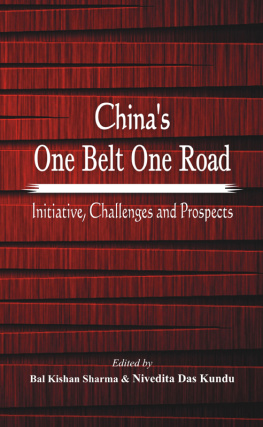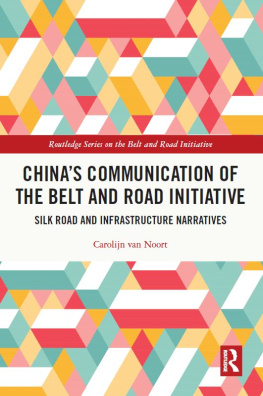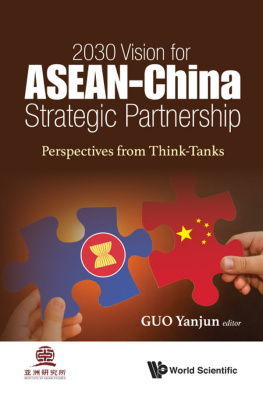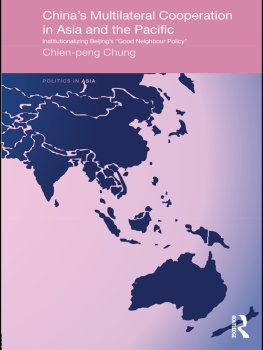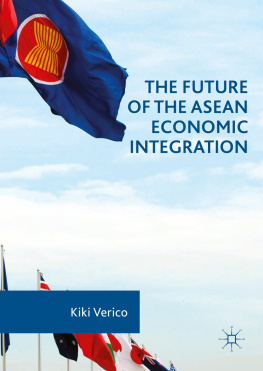Contents
Pagebreaks of the print version
Chinas Belt
and
Road Initiative
in ASEAN
Growing Presence, Recent Progress
and Future Challenges
Chinas Belt
and
Road Initiative
in ASEAN
Growing Presence, Recent Progress
and Future Challenges

Editors
Suthiphand Chirathivat
Chulalongkorn University, Thailand
Buddhagarn Rutchatorn
Chulalongkorn University, Thailand
Anupama Devendrakumar
VinUniversity, Vietnam

Published by
World Scientific Publishing Co. Pte. Ltd.
5 Toh Tuck Link, Singapore 596224
USA office: 27 Warren Street, Suite 401-402, Hackensack, NJ 07601
UK office: 57 Shelton Street, Covent Garden, London WC2H 9HE
Library of Congress Cataloging-in-Publication Data
Names: Suthiphand Chirathivat, editor. | Buddhagarn Rutchatorn, editor. | Devendrakumar, Anupama, editor.
Title: Chinas belt and road initiative in ASEAN : growing presence, recent progress and future challenges / editors Suthiphand Chirathivat, Chulalongkorn University, Thailand,
Buddhagarn Rutchatorn, Chulalongkorn University, Thailand,
Anupama Devendrakumar, VinUniversity, Vietnam.
Description: Hackensack, NJ : World Scientific Publishing, [2022] | Includes bibliographical references and index.
Identifiers: LCCN 2021045206 | ISBN 9789811241307 (hardcover) | ISBN 9789811241314 (ebook for institutions) | ISBN 9789811241321 (ebook for individuals)
Subjects: LCSH: China--Foreign economic relations--Southeast Asia. | Southeast Asia--Foreign economic relations--China. | China--Economic policy. | ASEAN.
Classification: LCC HF1604.Z4 S6453 2022 | DDC 337.51059--dc23/eng/20211109
LC record available at https://lccn.loc.gov/2021045206
British Library Cataloguing-in-Publication Data
A catalogue record for this book is available from the British Library.
Copyright 2022 by World Scientific Publishing Co. Pte. Ltd.
All rights reserved. This book, or parts thereof, may not be reproduced in any form or by any means, electronic or mechanical, including photocopying, recording or any information storage and retrieval system now known or to be invented, without written permission from the publisher.
For photocopying of material in this volume, please pay a copying fee through the Copyright Clearance Center, Inc., 222 Rosewood Drive, Danvers, MA 01923, USA. In this case permission to photocopy is not required from the publisher.
For any available supplementary material, please visit
https://www.worldscientific.com/worldscibooks/10.1142/12396#t=suppl
Desk Editors: Balamurugan Rajendran/Thaheera Althaf
Typeset by Stallion Press
Email:
Printed in Singapore
2022 World Scientific Publishing Company
https://doi.org/10.1142/9789811241314_fmatter
Preface
A study of ASEANs regional development, integration, and future will be incomplete without exploring its interconnectedness to China and Chinas rise in the region. Our co-edited book Chinas Belt and Road Initiative in ASEAN: Growing Presence, Recent Progress and Future Challenges addresses Chinas rise in the region by focusing on the Belt and Road Initiative (BRI). This book is the third in the publications series on Chinas Rise in Mainland ASEAN theme. Chinas influence shows no signs of slowing in Southeast Asias changing geostrategic and geoeconomic landscape. The impact of Chinas political-economic reforms in the past few decades have spilled to ASEAN, its immediate neighborhood. The public concerns about Chinas growing influence in ASEAN have escalated as their way of life is transforming at the local and regional levels. However, the knowledge base on the ongoing regional transformation is inadequate. The need to fill the knowledge gap by providing knowledge-sharing platforms to experts, instituting in-depth surveys, conducting research and case studies are dire. The knowledge-sharing opportunities would help discuss, reflect, debate the ground realities based on the local governments and local peoples experiences and narratives.
The Covid-19 pandemic hit the world when we were working on this book. The pandemic is raising tough questions about the nature of globalization. The post-pandemic global, regional integration will be a circumspect process. Chinas adaptation to the lessons of the pandemic and its post-pandemic resurgence is going to be robust. Thus, engaging the stronger China in the region will be even more challenging. In this context, despite the cautious and balanced approach adopted by most ASEAN countries vis--vis China, her expanding multifaceted influence will have long-lasting consequences. The rationale of this book has become all the more significant and relevant. The two previous books Chinas Rise in Mainland ASEAN: Changing Landscape and New Dynamics and Chinas Rise in Mainland ASEAN: Regional Evidence and Local Responses, published in 2019 and 2021, elaborate on how China has pursued broad development strategies, and how their impacts vary in ASEAN member countries. On the whole, China has played a decisive role in connecting to each ASEAN countrys growth, development, trade and investment, production and value chains, border connectivity, and people flows. It has established strong support, control, and influence in mainland ASEAN and beyond.
Encouraged by public responses to the previous two books in the series, this book focuses on the BRI in ASEAN as an investigative study. It examines how Chinas influence via BRI is growing in the Southeast Asian region. It is true that ASEAN, both mainland and maritime, is on high ground for Xi Jinpings massive and extremely well-financed BRI. Through the BRI, China has been fast expanding its geoeconomic and geostrategic influence in all ASEAN member countries, albeit there are differences in nature and magnitude. Overall, the BRI is well on its way in building every mode of transport infrastructure in the region: sea and land ports, roads and highways, conventional and high-speed rail, energy, telecommunications, and even exclusive Chinese building estates and casinos in many mainland ASEAN countries. However, BRI projects are also associated with risks and uncertainties. The usefulness and sustainability of these massive projects and their contribution to the development are unclear.
With Chinas rise and BRI in the region, questions abound regarding the nature and magnitude of their impact on ASEAN, its people, and society. Our book, and the series, delve into these questions. The general perception would be that ASEAN has been a key beneficiary of Chinas rise and the accruing opportunities from the BRI. However, Chinas strategic move in individual ASEAN countries extends its influence, interests, and connectivity, which might not be desirable and consistent with the way ASEAN has planned its integration with China. ASEAN does not want Chinas dominance, which could adversely affect member countries long-term welfare and development; overshadow the ASEAN Community building principles rules-based, caring, sharing, and people-centered; and ASEAN Way of doing things. The ASEAN Centrality cannot be compromised or overlooked.
The chapters in this volume address various BRI dimensions, provide unique perspectives, empirical evidence, and updated information on the overall progress of BRI in ASEAN. The authors, mostly from ASEAN and China, join in contributing their valuable insights on the subject. The authors from within the ASEAN region add distinct views and perspectives based on their first-hand experiences, observations, and access to local public narratives.




